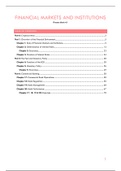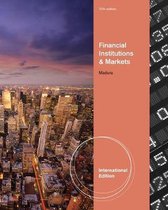FINANCIAL MARKETS AND INSTITUTIONS
Finance block 4.1
TABLE OF CONTENTS
Part 0: Cryptocurrency ............................................................................................................................................... 2
Part 1: Overview of the Financial Environment...................................................................................................... 5
Chapter 1: Role of Financial Markets and Institutions ...................................................................................... 5
Chapter 2: Determination of Interest Rates ..................................................................................................... 14
Chapter 2: Excercises...................................................................................................................................... 23
Chapter 3: Structure of Interest Rates .............................................................................................................. 24
Part 2: The Fed and Monetary Policy .................................................................................................................. 30
Chapter 4: Functions of the ECB ........................................................................................................................ 30
Chapter 5: Monetary Policy ............................................................................................................................... 36
Chapter 5: Excercises...................................................................................................................................... 49
Part 6: Commercial Banking ................................................................................................................................... 50
Chapter 17: Commercial Bank Operations ..................................................................................................... 50
Chapter 18: Bank Regulation ............................................................................................................................. 55
Chapter 19: Bank Management ........................................................................................................................ 60
Chapter 20: Bank Performance ......................................................................................................................... 67
Chapter 17, 18, 19 & 20: Exercises ............................................................................................................ 70
1
,PART 0: CRYPTOCURRENCY
Cryptocurrency:
Cryptocurrency Digital asset designed to work as a medium of
exchange using cryptography to secure the
transactions and to control the creation of
additional units of the currency.
Cryptocurrency is generally anonymous and not issued by any single authority. Supply is regulated
by software and agreement of users of the system (network) and therefore, cannot be manipulated
by any government, bank, organization or individual.
Cryptocurrency can only be obtained by:
− Mining;
− Receipt of payment;
− Purchases.
Similarities between cryptocurrency and conventional money:
− Gold standard: Finite amount;
− Fiat Money: No intrinsic value and purchasing power fluctuates.
Unique features of cryptocurrency:
− No physical form;
− Not legal tender;
− Supply not determine by central bank or monetary authority;
− Peer to peer transactions;
− Algorithms determines creation of new cryptocurrency coins.
Similarities and differences between cryptocurrency and conventional money:
CONVENTIONAL CURRENCY CRYPTOCURRENCY
− Type: Real and tangible Virtual and intangible
− Intermediaries: Yes, financial institutions No, peer to peer
− Portability: Yes, expect for heavy cash High portable
− Durability: Moderate, wear and tear High durable
− Acceptability: National Global, through the internet
− Security: Moderate High
− Scarcity: Low, easy to print High
− Sovereignty: Yes, government issue No
− Control: Yes, central bank control Yes, complex math and market cap
− Programmability: No Yes, blockchain
2
,Advantages and disadvantages of cryptocurrency:
ADVANTAGES DISADVANATGES
− Fast, safe, cheap; − Targets for hackers and scammers; (cheat people with
fake opportunities)
− Ease of use, highly portable; − Fewer protection to consumers from fraudulent
transactions; (compared to credit cards)
− Untraceable; (pseudo-anonymous − Can cost more due to price volatility;
transactions and link to wallet)
− Transparent and neutral; − Lack of transparency and accountability due to
pseudonymous nature;
− Decentralized nature; − Money laundering; (methods such as tumbling obscures
source of cryptocurrency)
− Active involvement of users; − Purchase of illegal goods; (drugs, human trafficking,
human organs such as kidneys) (Silk Road, DarkNet)
− Fewer risks for merchants; − Used by criminal syndicates;
− Freedom to transact; − Little to no legal protection or recourse.
− Low inflation and collapse risk.
Major cryptocurrencies:
Bitcoin:
− Cryptocurrency and an electronic
payment system;
− Invented by Satoshi Nakamoto in Japan
in 2008;
− First decentralized payment network;
− Completely open source;
− System is peer to peer;
− 1 BTC = 6.238,81 USD.
3
, Regulations on cryptocurrency:
− USA:
− Depends on whether cryptocurrency is considered a currency or property. If it is considered a
property, then it becomes taxable in terms of capital gains/losses;
− Classification of whether currency or property influences its regulation. In Congress,
Cryptocurrency Protocol Protection & Moratorium Act (CryptPMA) was not approved. It
prevented US government from creating restrictions and regulations on use of algorithmic
protocols and declared cryptocurrency as currency and not property;
− New York initiated licensing law called BitLicense requiring individuals to obtain a license in
engaging in any virtual currency business activity.
− UK: Government plans to regulate cryptocurrencies;
− Japan: Considering licensing scheme for exchange;
− China: Prohibits financial institutions from handling cryptocurrencies;
− Europe: Advised financial institutions to trade in cryptocurrencies only if they can be regulated;
− Brazil: No regulations on cryptocurrencies.
Conclusion:
Cryptocurrency is an impressive technical achievement, but it remains a monetary experiment. Even if
cryptocurrencies survive, they may not fully displace fiat currencies. They provide an interesting new
perspective from which to view economic questions surrounding currency governance, the characteristics
of money, the political economy of financial intermediaries, and the nature of currency competition.
4






